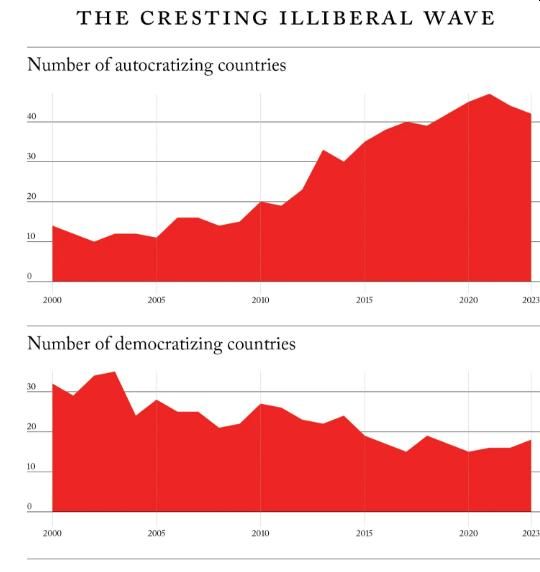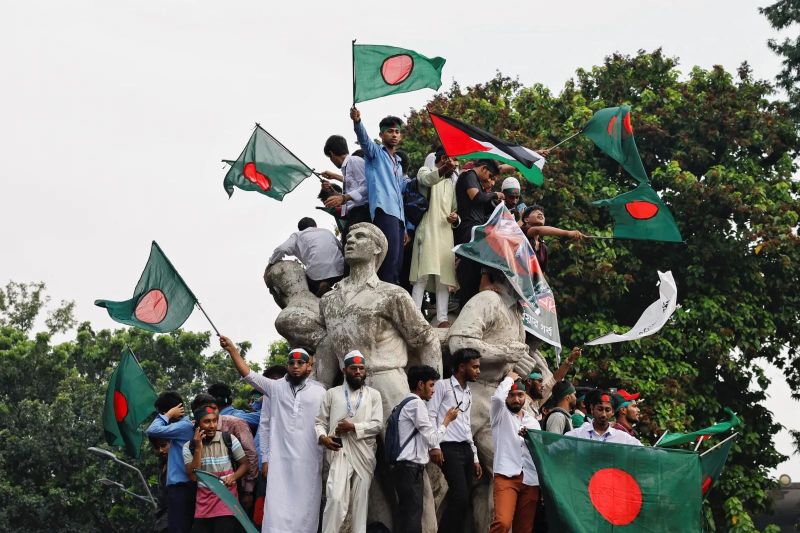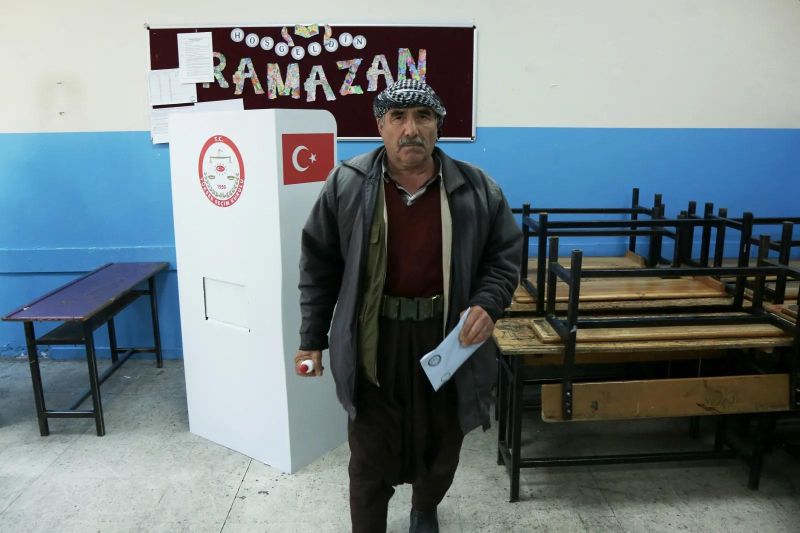By Eric Vandenbroeck and co-workers
How to End the Democratic Recession
On August 5,
following weeks of mass student protests, a dictator fell in the world’s eighth
most populous country. Amid wars in Ukraine and Gaza, the escalating danger of
a wider conflict in the Middle East, and the twists and turns of the U.S.
presidential race, the sudden resignation and flight into exile of Bangladesh’s
prime minister, Sheikh Hasina, drew slight global attention. But the
significance of her ouster could prove substantial. Hasina, the daughter of the
independence leader and first president of Bangladesh, first served as prime
minister from 1996 to 2001 and was elected to the office again in 2008. In
three successive terms over the next 15 years, she ruled with mounting
ruthlessness and resolution. She asserted personal control over the courts,
prosecutors, government agencies, and the police, using them to silence the
media, persecute her opponents, cow private business, and subvert the
institutions and traditions that previously allowed for reasonably free and
fair elections. By the time Bangladeshis voted again, in 2014, Hasina had so
trampled on constitutional norms that most opposition parties chose to boycott
the election, accelerating the country’s descent into autocracy and misrule.
Yet Bangladesh’s civil society refused to remain silent in
the face of a rising tide of arrests and disappearances. In January 2024, as
Hasina prepared to glide into a fourth consecutive term in another unfair
election (which also was boycotted by the opposition), popular protest
intensified. In June, the dam burst. The trigger was a seemingly modest issue:
the reinstatement of a quota system for government jobs that was seen to favor
Hasina’s political base. Bangladeshi university students took to the streets,
angered by the prospect of a spoils system. Hasina responded with repression:
her party’s shock troops joined the fray, and she sent in the police and the
military. Over the next two months, hundreds of civilians were killed, more
than 20,000 injured, and more than 10,000 arrested. The government’s brutality
turned a limited protest movement into a nationwide civil disobedience campaign
against tyranny and corruption. In the end, after losing the support of the
military, Hasina fled to India.
One could argue that
bringing down a dictator was an easier job in Bangladesh than it would be
elsewhere. No Bangladeshi party or movement had institutionalized ideological
and political control over the state, security apparatus, and economy the way
revolutionary communist parties had in China, Cuba, and Vietnam, the ayatollahs
had in Iran, or, to a lesser extent, Hugo Chávez’s
“Bolivarian socialist” movement had in Venezuela.
However many of the autocratic regimes that have emerged in the past decade
have followed a path similar to Bangladesh’s. Corrupt leaders have hollowed out
democratic institutions and established authoritarian rule behind the façade of multiparty elections. Following a common
playbook, they wholly dismantled democracy in El Salvador, Hungary, Nicaragua,
Serbia, Tunisia, Turkey, and Venezuela. Elsewhere, similar tools have been used
to degrade democracy. However, whether those countries crossed the line into
autocracy is debatable: recent examples include Georgia, Honduras, India,
Indonesia, the Philippines, and Sri Lanka. Illiberal practices have also eroded
the quality of democracy and the public’s support for it in Botswana and
Mauritius, Africa’s oldest multiparty systems. Corrupt and domineering ruling
parties in Mongolia and South Africa have overseen democratic declines,
although recent elections dealt severe setbacks to both. In Mexico, by
contrast, a move by Andrés Manuel López Obrador as outgoing president could further erode
the country’s precarious rule of law. A new constitutional amendment requires
all judges to be popularly elected, undermining the independence of the
judiciary and putting the future of the country’s democracy at risk.

Most of these
countries are not full-blown dictatorships. Rather, they have joined (or
gravitated toward) the ranks of what the political scientists Steven Levitsky
and Lucan Way term “competitive authoritarian” regimes. The description
encompasses a core contradiction. The ruling elites will not commit to the
constitutional norms that allow for free elections and government
accountability, but the people will not tolerate the complete elimination of
individual freedoms, civic pluralism, multiparty elections, and at least the
possibility of parties alternating in power. Many countries, such as Kenya,
Nigeria, and Tanzania, have lingered in this halfway house for some time.
Others, such as Pakistan and Thailand, do so with the added complication of
militaries that hold political veto power.
The global outlook
for democracy is clouded, if not downright disheartening. Political extremism,
polarization, and distrust have been on the rise even in long-established
liberal democracies, and doubt about the democratic commitment of one of the
two major-party candidates is a major issue in the U.S. presidential race this
year. But there are glimpses of sun behind the clouds. Bangladesh is not the
only example. The struggle for freedom escalated in Venezuela after a stolen
election in July, with the opposition presenting overwhelming evidence of its
landslide victory. Thailand’s military-backed regime has faced a deepening
crisis of legitimacy since courts blocked the winner of the May 2023
parliamentary elections from taking power. Turkey’s electoral autocracy looks
increasingly worn and fragile, with the country’s long-ruling strongman, Recep
Tayyip Erdogan, barely eking out a victory over a colorless opponent in the May
2023 presidential vote. Last year as well, stunning opposition victories in national
elections brought a restoration of democratic practices in Poland and a
historic opportunity in Guatemala
to move past the country’s troubled history of autocracy and corruption. And
the past two election cycles in Malaysia suggest a shift toward democracy after
six decades of what seemed a stable competitive authoritarian regime: a
makeshift coalition ended the six-decade rule of the Barisan Nasional coalition
in 2018, and voters then made the principal opposition leader, Anwar Ibrahim,
prime minister in 2022.
In other words,
today’s autocrats are not invincible. Many rely on elections, albeit deeply
flawed ones, to maintain an air of legitimacy. But this means they can be
defeated. Determined domestic opposition fronts, backed by the larger community
of liberal democracies, can reverse the trend of global democratic backsliding.
To be successful, they will need to grapple with the drivers of the
antidemocratic trend, weaken the pillars that prop up the fake democracy of
authoritarian populism, and apply the lessons of previous successful campaigns
against authoritarian rulers. Just as autocrats employ a common set of tools to
acquire and maintain power, their opponents must start following the playbook
for democratic change.
Democracy In Retreat
Democracy’s global
momentum peaked soon after the end of the Cold
War. For the first time in history, systems in which people could choose
and replace their leaders in free and fair elections became the predominant
form of government. By 2006, about three-fifths of all countries met this
standard. Since then, democracy and freedom have been in steady retreat. For 18
consecutive years, the nonprofit group Freedom House—which tracks changes in
political rights, civil liberties, and the rule of law and assigns countries
and territories an annual “freedom score” on a scale of zero to 100—has counted
more countries losing freedom than gaining it. Often, the difference is a
two-to-one ratio or worse. The Swedish-based project V-Dem has identified a
similar but somewhat more recent unfavorable trend.
The decline has been
global. Average levels of democracy, as measured by Freedom House, V-Dem, and
the Economist Intelligence Unit, have dropped in every region of the world
since 2006. The changes have not always been disastrous, but they have been
remarkably broad and persistent. Of the 22 sub-Saharan countries that shifted
significantly on democracy scales during this period, 18 underwent declines,
and of the four that improved, three—Angola, Gambia, and Zimbabwe—simply became
less abusive autocracies. Globally, those three are outliers; most autocracies,
including Cambodia, China, Egypt, Ethiopia, Iran, Myanmar, and Russia, have
become significantly more repressive.

The euphoria that
attended the heady expansion of democracy from the mid-1970s to the first few
years of the twenty-first century—the “third wave” of democratization—now seems
a distant memory. A few places, such as Armenia, Bhutan, Colombia, Malaysia, Moldova,
and Taiwan, have seen notable gains in recent years, but genuine democratic
breakthroughs have been few and far between. Iran’s government crushed one
popular rising, the Green Movement, in 2009 and another, the Woman, Life,
Freedom movement, in 2022. All the Arab Spring uprisings were ultimately
suppressed save for the one in Tunisia, where a fledgling democracy stumbled on
until the president moved to dismiss parliament and the prime minister in 2021.
The same year, Myanmar’s military ended an experiment in semi-democracy when it
overturned the results of the country’s 2020 elections, closed parliament, and
arrested senior civilian officials, plunging Myanmar into a bloody conflict.
Autocratic Enablers
What sent the world
spinning toward autocracy? The answer varies from country to country, but
certain factors stand out. To some extent, a course correction may have been
inevitable as democracy spread to many countries that lacked the economic base
and rule-of-law institutions to control corruption and deliver sustained
progress. Yet this does not explain every case of backsliding; some very poor
countries, such as Liberia and Malawi, have largely managed to keep their
democratic gains.
Another driver is the
series of reputational blows that liberal democracy suffered in the first
decade of the twenty-first century. First, the 2003 U.S. invasion of Iraq
tarnished the idea of promoting democracy by linking it to the use of military
power to force regime change—to disastrous effect. Then, only a few years
later, a global financial crisis destabilized many governments, including
democratic ones. It had originated in the United States, a supposed model
democracy, when the country’s mortgage industry came crashing down after a
decade of government failure to rein in predatory practices.
It was not just
democracies that sullied their own image; illiberal actors helped them along.
China used its growing wealth, propaganda, technology, and mechanisms of covert
influence to promote its authoritarian governance model and dim the attractions
of open societies. The Russian government worked in similar ways to denigrate
democracy and destabilize democratic institutions, such as by intervening in
elections. After taking office in 2010, Hungarian Prime Minister Viktor Orban
crafted a deeply illiberal pseudo-democracy that appealed to far-right
anti-immigrant and nationalistic forces around the world.
At first, social
media enabled citizens to circumvent autocratic states’ control of information
and organize for democratic change. Although online platforms are still used
for these purposes, their positive role has been overshadowed by the advance of
authoritarian means of digital surveillance and repression and by the
polarizing effects of social media algorithms, which autocracies can exploit to
divide and demoralize democratic societies. Artificial intelligence is now
beginning to supercharge these efforts.
The digital
technology boom joined a snowballing set of global trends that undermined
popular support for democracy and created fertile ground for the rise of
illiberal populist parties. Dramatic increases in income inequality in both
advanced and emerging economies meant soaring wealth for a small fraction of
top income earners and economic stress for much of the middle and lower
classes, which became pessimistic about the future and cynical about the
parties and politicians who had failed them. Inequality then fed into political
polarization, which was further intensified by the accelerating movement of
diverse people, ideas, and cultures across borders and by campaigns for gender
and racial equality that upset long-settled hierarchies of social status. To
exploit the public backlash, politicians in many advanced democracies,
particularly in Europe and the United States, framed large waves of immigration
as a threat to economic health, social stability, and national character. Their
rhetoric severely distorted reality, but it played to people’s fears.
These trends
coincided with a historic shift in global power. From 1960 to 1990, the U.S.
share of global economic output declined from two-fifths to around one-quarter,
where it remains, and Europe’s share has shrunk since 1960 by roughly half. At
its peak in the early 1990s, Japan accounted for nearly one-fifth of global
GDP; now its share is just three percent. Meanwhile,
China has risen to become the world’s second-largest economy, ranking behind
only the United States, and India’s economy is now closing in on Germany’s and
Japan’s. China and Russia have used corruption, coercion, and propaganda to
sway and subvert open societies, and their militaries have cast long, alarming
shadows in their respective neighborhoods. In sum, while Beijing and Moscow (and
Tehran) bully their way into reshaping world politics, the advanced
democracies, with their diminished economic and geopolitical standing, have a
weakened hand and are playing it cautiously. The “unipolar moment” immediately
after the Cold War, when autocrats made political decisions under the shadow of
American power, is long past.
At a rally in Dhaka, Bangladesh, September 2024

Then there is the
human factor. Restraint in the exercise of power is not a natural tendency.
This is why the framers of the first constitutional democracy, the United
States, understood the need to check and balance power, following the
Madisonian principle that “ambition must be made to counteract ambition.” “If
you want to test a man’s character,” goes one aphorism, “give him power.”
Unencumbered by strong constitutional guardrails, most men—and, like Sheikh
Hasina and Indian Prime Minister Indira Gandhi before her, some women—who get
the opportunity fail the test.
Over the past two
decades, critical constraints on human behavior have lifted. Ambitious
politicians have observed the rhetoric and methods their peers abroad have used
to dismantle democracy, piece by piece. These aspiring autocrats have learned
from examples of success and acted on those lessons, emboldened by the
inability of domestic and international actors to restrain them. Once, the
diffusion of political ideas helped foster democratic transitions. Today, it
facilitates democratic backsliding.
Furthermore,
constitutions restrain rulers only if they are enforced. When these documents
are embedded in norms, incentives, and expectations, violations are rare and
tend to fail because powerful actors rise to reaffirm the constitutional order
out of both conviction and self-interest in sustaining the rules of the game.
But when severe political polarization generates a sense of existential risk—a
fear that losing an election could mean the permanent loss of political power
and even one’s livelihood and freedom—these dynamics change. A politician with
sufficient skill and will to override constitutional norms can embark on the
road to autocracy.
Exposing the Fraud
Today’s autocrats
mainly come to power at the ballot box, and they remain in power while
maintaining a façade of competitive elections. Of
the roughly 30 countries that have lost their democracies since 2006, all but
three (the Sahelian coup countries—Burkina Faso, Mali, and Niger) have followed
this pattern. Holding votes gives autocrats a claim to legitimacy, but it also
makes them vulnerable. The elections they stage may be deeply unfair, but the
incumbent autocrat can still lose and be compelled to leave office. To restore
democracy through elections, however, domestic defenders of democracy and their
supporters abroad must be able to identify authoritarian populism and
understand how it works.
First, authoritarian
populists purport to defend “the people”—the true, virtuous majority—against a
corrupt establishment that has hijacked power and exploited them. In this
narrative, there are not just good and bad policies; there are good and evil
people. The ruling elites and their allies are morally bankrupt and must be
vanquished, even as some of those allies, especially in the business community,
opportunistically throw in their lot with the populists. Drawing so stark a
divide enables the populist contender to claim a mandate to persecute opponents
and purge the civil service on coming to power. Resorting to that tactic
explains another key feature: populists are anti-institutional. They disparage
the existing economic and political institutions, even the constitution itself,
as the rotten structures of a rotten elite. Then they dismantle institutional
safeguards and weaponize state power.
On a societal level,
populists reject pluralism. They see no need to make space for multiple ways of
thinking and believing. The country has one identity, and people who are
different—by faith or ideology or national origin or sexual identity—are
deviant and dangerous. They must be watched, controlled, or removed. Finally,
populism is personalistic and hegemonic. Since leaders are the saviors of their
countries against evil forces, they must be granted extraordinary unfettered
power. Elections are no longer instruments of political accountability and
constraint but rather plebiscites to revalidate leaders and their political
monopolies.
Inevitably, an
authoritarian populist regime becomes intolerant, xenophobic, and corrupt. More
than its bigotry—perhaps even more than its violation of democratic norms—this
corruption, drawn from a sense of moral entitlement to gorge on public
resources, is its Achilles’ heel.
The key to defeating
authoritarian populism is to expose its vanity, duplicity, and venality, to
show it to be not a defense of the people but a fraud upon the people. This
requires independent reporting to reveal corruption. It requires using,
whenever possible, countervailing institutions—regulatory bodies, auditing
agencies, the judiciary, the police, the civil service, and, if there is a
significant opposition presence, the legislature—to disclose and curtail abuses
of the public trust. Elements of civil society, such as bar associations,
trade unions, student groups, and other professional and civic organizations,
can be important allies in this cause. Resistance is more effective when
mobilized early; the longer populist authoritarians hold on to power, the more
they chip away at institutional constraints. One reason illiberal parties did
not fully subvert democracy in Poland or, at first, in Mexico, unlike in
Hungary, Turkey, or Venezuela, is that they did not win sufficient majorities
in parliament or through a direct vote to amend the constitution. Enough
judicial and other institutional independence remained to limit the
authoritarian slide. That constraint was lifted in Mexico with the June
election when López Obrador’s party won enough seats
in Congress to push through constitutional change.
Turning the Tide
Once the
authoritarian project conquers the country’s institutions, resistance from
within the state is no longer possible. Mass mobilization is required to defeat
it. Success is much more likely if the democratic movement is peaceful and
operates within legitimate institutional boundaries. Demonstrations, strikes,
and other forms of nonviolent civil resistance may slow or halt the descent
into authoritarianism—or even force an autocrat to flee, as seen in Bangladesh
this year and in Ukraine after the Euromaidan protests of 2014. But the most
promising route is still through the ballot box. Repeatedly over the past
decade, in countries as diverse as Bolivia, Brazil, Ecuador, Guatemala, Poland,
Senegal, Sri Lanka, Zambia, and—yes—the United States, democratic elections and
the enforcement of term limits have curtailed an authoritarian drift. In India
in May, they eroded the ruling Bharatiya Janata
Party’s iron grip on the parliament, which might diminish the party’s readiness
to abuse power to stifle dissent. In Belarus, Hungary, Turkey, and Zimbabwe,
opposition campaigns fell short, unable to overcome the obstacles posed by
entrenched authoritarian regimes to free and fair elections. But the progress
they made is notable. In Belarus’s case, the opposition candidate for president
likely won the 2020 election, but the dictator Alexander
Lukashenko declared patently false results.
Opposition
mobilization has worked in earlier eras, too. Globally, the third wave of
democratization was driven in part by opposition movements that overcame
repression and fraud by documenting their electoral victories through
independent vote tabulation at polling stations and by rallying mass protests.
The first successful “color revolution” to bring about a democratic transition
after a disputed election unfolded in the Philippines in 1986, followed by
Serbia in 2000, Georgia in 2003, Ukraine in 2004–5, and Kyrgyzstan in 2005. In
a few other cases, ruling autocrats were stunned by their electoral defeats but
accepted the outcome and ceded power without the need for mass protests.
Both the earlier and
more recent electoral victories for democracy share other important
features. Opposition forces united behind a single electoral platform or, as in
Poland last year, coordinated their parliamentary campaigns to avoid dividing
the vote. In each case, the authoritarian ruling party was deeply unpopular,
internally divided, or both. In some cases, external pressure from liberal
democracies raised the costs of repression and encouraged defections by the
elite. And the incumbents’ ability to cling to power by using blatant
falsehoods and blunt force was constrained by independent media, divisions
within the security forces, or the latter’s unwillingness to fire on their own
people.

Successful campaigns
against authoritarian populists have shared some basic messaging strategies.
They craft broad political appeals to mobilize the largest possible electoral
base, even courting voters who supported the autocrat in the past. They seek to
unify the country, not divide it. Authoritarian populists thrive on and excel
at polarization; their democratic opponents must undercut that cynical
strategy. They must show empathy and humility, welcoming culturally,
ethnically, and ideologically diverse segments of society to join the
democratic cause. In Turkey, for example, the opposition’s astonishingly
successful municipal election campaigns in 2019 and 2024 pursued a strategy of
“radical love”—an explicit rejection of the ruling Justice and Development
Party’s rhetoric of hate and division. Democratic aspirants, moreover, must
call out the incumbent’s failures and must foreground issues that matter to
ordinary voters, such as improving the country’s economic performance, ending
corruption, and delivering services that will improve people’s lives. Their campaigns
should recapture patriotism, emphasizing pride in the nation as a democracy.
They should not be dour but rather present a confident vision of a better
future. They should not be boring, either. A successful campaign is one infused
with creativity, energy, passion, and even joy. Finally, as the political
scientist Steven Fish has urged, those seeking to unseat an autocrat cannot be
weak. They must project conviction, with forceful appeals to voters’ interests
and values. They must show that strongman rule is not the only form of strong
leadership.
Voting in Diyarbakir, Turkey, March 2024

External support is
also critical. Lately, however, liberal democracies have been sitting on the
sidelines as China and Russia stand behind autocrats who rig and
terrorize their way to electoral victory, such as Lukashenko in Belarus in
2020, Emmerson Mnangagwa in Zimbabwe last year, and Nicolás
Maduro in Venezuela in July, or, in the case of Pakistan, as the military
barred former Prime Minister Imran Khan from running for parliament in the
February election. Amid heightened strategic competition with an emerging axis
of autocracies that includes China, Russia, and Iran, powerful democracies,
particularly the United States and major European countries, are hesitant to
use all the diplomatic, informational, and economic tools at their disposal to
support democratic change.
To reverse the global
democratic slide, the liberal democracies must get back in the game. A test of
their resolve is already underway in Venezuela, where the opposition has
compiled official tallies from over 80 percent of polling stations to
demonstrate that its candidate, Edmundo González,
defeated Maduro in a landslide in the July presidential election. With the
backing of China, Russia, and Cuba, as well as the loyalty of the country’s
military and security establishment, Maduro has brutally repressed protests
demanding that he acknowledge the results and peacefully transfer power. Ending
Venezuela’s authoritarian nightmare, which has already prompted more than a
fifth of the population, some eight million people, to flee the country over
the past decade, now requires an intense diplomatic effort. Brazil, the United
States, and democracies in Latin America and Europe need to coordinate their
efforts to persuade Maduro and his allies to accept the opposition’s offer of
immunity from prosecution in exchange for a transfer of power. Negotiations
require carrots and sticks. An international coalition must not only prepare to
make painful concessions on amnesty (including shielding members of the
Venezuelan regime from prosecution in the United States and assuring them safe
passage abroad) but also threaten the elite with punishing sanctions on their
foreign assets and with blocking family visas if they continue to resist the
will of the Venezuelan people.
It is rare to
encounter such a glaring and well-documented example of an autocrat facing
electoral defeat and a broad, passionate societal aspiration for change.
Venezuela is ripe for a democratic transition, and the world’s liberal
democracies must do all they can to help it along.
Freedom Reborn
The challenges
confronting democracy today are formidable. Authoritarian regimes have gone on
the offensive to discredit and destabilize free societies. That they do so out
of fear and concern for their own legitimacy does not make their actions any
less dangerous. Making matters worse, hostile autocracies are increasingly
acting in concert in a malevolent axis that features China, Russia, and Iran at
the center, joined by Cuba, North Korea, and others. Protecting democracy
against such forces will take strength, agility, and tenacity. The world’s
liberal democracies must enhance their external defenses and cooperate more
closely to maintain an economic, military, and technological edge that denies
antidemocratic adversaries the power to dominate global politics and undercut
their rivals.
At the same time, as
underscored by the recent electoral gains of extremist populist forces on both
the right and the left in France and Germany, democratic leaders cannot neglect
their internal defenses. Emerging and mature democracies alike need strategies
to counter the siren song of illiberal populism. Even a long-standing liberal
democracy can turn toward autocracy if its government does not deliver
effective policies to combat crime and terrorism, manage national borders,
soothe societal divisions, and ensure broad access to economic opportunity and
security.
In their global
outreach, liberal democracies must push back against authoritarian campaigns of
disinformation and covert influence. They must make bigger and
better-coordinated investments in development assistance to foster economic
growth and the rule of law that make countries partners for democracy rather
than captives of autocracy or failed states. To win the war of ideas, they need
to disseminate democratic values, lessons of success and failure, and sources
of true information.
The possibility of a
democratic transition cannot be written off in any country. Autocracies live in
fear that what happened to seemingly impregnable one-party communist regimes in
the late twentieth century will happen to them. At any time, a leader’s death
or a sudden crisis can open an opportunity to sweep away an entrenched
autocracy. But proponents of democracy can do more than simply wait.
Competitive elections, even when they are not free and fair, are mobilizing
events charged with opportunity for change. When those moments come, they must
be seized not only by voters but also by other democratic countries.
Ahead of an election,
democracies can provide opposition groups with the funding and training they
need to conduct parallel vote tabulations. They can help political parties
mount more substantive and effective campaigns. They can provide technical and
financial assistance to election management bodies. They can help civil society
organizations identify and counter disinformation and foreign interference on
social media. They can send in independent observers during the campaign, the
vote, and the vote count to fortify domestic monitoring efforts. If the
opposition wins and the incumbent is reluctant to step down, democracies may
need to offer concessions to the defeated autocrat in exchange for accepting
the results—and potentially bring withering pressure down on the regime if it
refuses.
When promising
opportunities for democratization arise, as witnessed this summer in Bangladesh
and Venezuela, they should command focused international attention. But the
agencies and networks that support democratic transitions should also keep an
eye trained on elections in the years ahead. In many countries that have edged
away from democracy or have not yet fully secured it, voters will continue to
face critical choices at the ballot box. Elections will provide opportunities
to advance democratic progress in countries such as Armenia and Malaysia; to
reverse democratic backsliding in Botswana, Georgia, India, Indonesia,
Mauritius, Mongolia, the Philippines, and Serbia; to achieve meaningful
democracy in Gambia, Kenya, Nigeria, Pakistan, and Thailand; to dislodge
autocracy in countries where the possibility is often dismissed, such as
Zimbabwe; and to someday put countries torn apart by conflict, such as Ethiopia
and Sudan, on a path to peace and political accountability.
Scholars and
policymakers understand what the political scientist Terry Karl once called
“the fallacy of electoralism.” A democratic election is only a beginning.
Without honest and effective governance, a capable state, the rule of law, an
independent judiciary, and a vigilant civil society, democracy will not deliver
the economic growth, physical infrastructure, social services, public health,
human rights, and safety and security that its voters expect. Helping
democratically elected governments gain access to the financing, investment,
training, and direct assistance they need to serve their people effectively
remains a vital task of official aid agencies, such as the U.S. Agency for
International Development, and of private foundations.
After a two-decade
democratic retreat, the tide must now turn. Competitive elections are not the
end of the story, but they provide the most promising and abundant
opportunities to move in a positive direction politically. A concerted strategy
of international engagement to support free elections could blunt the march of
illiberal populism, strengthen civil societies, help restore democratic
vitality in pivotal countries, and yield the largest harvest of democratic
transitions since the global democratic recession began. Once democracy regains
its momentum, even entrenched dictatorships will be under pressure. The
alternative is a continued authoritarian drift toward a world of increasing
polarization, repression, conflict, and violence. A world dominated by China,
Russia, Iran, and lesser autocracies unburdened by concerns for human rights
and the rule of law. A world hostile to the interests and values not just of
the United States but of freedom-loving people everywhere.
For updates click hompage here